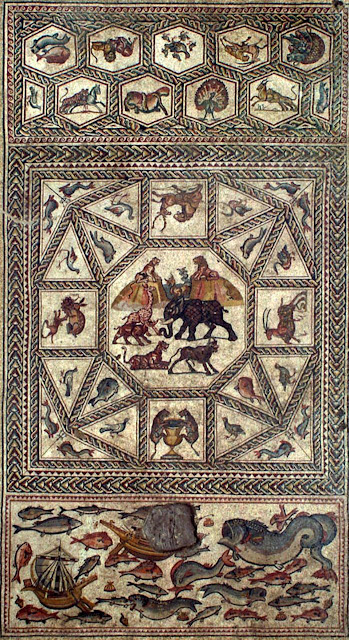Remarkably conserved, this great mosaic was discovered in Lod in 1996 during the construction of a highway between Tel Aviv and Jerusalem. This unique pavement, decorating the floor of a house, presents abundant animal life inserted into geometric patterns.

A vast mosaic, perfectly conserved
Uncovered during salvage excavations led by archaeologist Miriam Avissar at the site of ancient Lydda, the mosaic belonged to an even larger pavement of which it was the essential decorative piece. The function of the room it occupied, as well as the nature of the building and the identity of its occupants are unknown. Some remaining coats of paint discovered at the time of the excavation, reproducing colored plaques of false marble, show that the walls of the room were also decorated: it could thus have been used as a reception room.

An intriguing bestiary for an exceptional mosaic
The decor of the mosaic is organised into three zones: a central section, almost square, flanked on either side by two rectangular panels.
The animal world is represented in all of its diversity and with great attention to detail: fish, mammals, and birds, from which we can identify the different species, are grouped in compositions or are isolated against geometric patterns. Apart from the sea monster in the central medallion and in the secondary section, the animals are treated with a realism that is highly common in the art of mosaics, particularly in the Near East.
The human figure is not represented but human activity is evoked by two boats floating in the sea surrounded by marine life.
The central octagonal medallion presents a surprising spectacle of exotic animals ‒ elephants, giraffes, tigers, rhinoceroses… ‒ seemingly living in harmony, under the protection of peaceful lions, watching over a path towards the sea from which appears a sea monster. This scene could reference the society of Lydda during the Roman Empire when citizens of different beliefs coexisted in peace.
The presentation of the Mosaic of Lod at the Louvre
The cour du Sphinx, closed to the public for several years, welcomes this large work (33 m2) and will reopen for the occasion. Exhibited in the spaces reserved for Roman antiquities, the mosaic equally inscribes itself into the galleries for the Eastern Mediterranean Provinces of the Roman Empire, inaugurated in September 2012, which present a group of recently restored mosaics from the Near East.
An audiovisual guide will provide context to the elements presented to the visitors.
The Mosaic of Lod is exceptionally presented in Paris before joining the center for research on the mosaics of Lod, under construction at the site of the discovery.
Source: Louvre Museum [May 24, 2013]